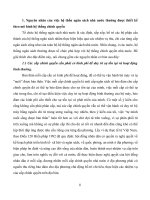Bài 3 Lập trình mạng thiết kế theo mô hình MVC_TS Nguyễn Mạnh Hùng
Bạn đang xem bản rút gọn của tài liệu. Xem và tải ngay bản đầy đủ của tài liệu tại đây (550.52 KB, 33 trang )
Lập trình mạng
Thiết kế theo mô hình MVC
Giảng viên: TS. Nguyễn Mạnh Hùng
Học viện Công nghệ Bưu chính Viễn thông (PTIT)
2
Nội dung
Mô hình MVC tổng quan
Mô hình MVC cải tiến
Ví dụ
Bài tập
Mô hình MVC
4
Mô hình MVC (1)
[image source: />5
Mô hình MVC (2)
M - model:
Đóng gói dữ liệu, thông tin
Chức năng biểu diễn, vận chuyển thông tin
để trình diễn (view) và xử lí (control)
6
Mô hình MVC (3)
C - control:
Định nghĩa các hành vi, hoạt động, xử lí
của hệ thống
Đối chiếu hành động của user (nhận từ
view), vào tập chức năng để xử lí, đồng
thời chọn hành động đưa view ra để show
7
Mô hình MVC (4)
V - view:
Giao diện với người dử dụng
Show các kết quả xử lí của tầng control
Thu nhận các hoạt động, yêu cầu của
người sử dụng và chuyển cho tầng control
xử lí
8
MVC cải tiến (1)
[image source: />9
MVC cải tiến (2)
View
Control
Model
L. giao diện
L. điều khiển
L. thực thể
10
Các lớp thực thể
Đóng gói dữ liệu, thông tin
Chỉ chứa các thuộc tính và các phương
thức truy cập các thuộc tính (javaBean)
Chức năng biểu diễn, vận chuyển thông tin
để trình diễn (view) và xử lí (control)
11
Các lớp điều khiển
Cập nhật thông tin vào DB (thông tin chứa
trong các thực thể)
Thực hiện các tính toán, xử lí trung gian
Đối chiếu hành động của user (nhận từ
view), vào tập chức năng để xử lí, đồng
thời chọn hành động đưa view ra để show
12
Các lớp giao diện
Các frame, cửa sổ của ứng dụng
(javaSwing)
Các trang giao diện web: html, jsp
Các bảng, mẫu biểu, báo cáo in ra
Ví dụ:
điều khiển đăng nhập từ dòng lệnh
14
Login: Model
public class LoginModel {
String userName;
String password;
public LoginModel(){}
public String getPassword() {
return password;
}
public void setPassword(String password) {
this.password = password;
}
public String getUserName() {
return userName;
}
public void setUserName(String userName) {
this.userName = userName;
}
}
15
Login: View (1)
import java.io.DataInputStream;
import java.io.IOException;
public class LoginView {
LoginModel user;
public LoginView(LoginModel user){
this.user = user;
}
public void showMessage(String smg){
System.out.println(smg);
}
16
Login: View (2)
public void getUserInfo(){
try{
DataInputStream input = new DataInputStream(System.in);
System.out.print("Username: ");
user.setUserName(input.readUTF());
System.out.print("Password: ");
user.setPassword(input.readUTF());
input.close();
}catch(IOException e){
System.out.println(e);
}
}
}
17
Login: Control (1)
public class LoginControl {
LoginModel user;
LoginView view;
public LoginControl(LoginModel user, LoginView view){
this.user = user;
this.view = view;
while(true){
view.getUserInfo();
if(checkLogin()){
view.showMessage("success!");
break;
}else{
view.showMessage("wrong username or password!");
}
}
}
18
Login: Control (2)
private boolean checkLogin(){
if ((user.getUserName().equals("sa"))
&&(user.getPassword().equals("sa") )){
return true;
}
return false;
}
}
19
Login: main
public class LoginMVC {
public static void main(String[] args){
LoginModel user = new LoginModel();
LoginView view = new LoginView(user);
LoginControl control = new LoginControl(user, view);
}
}
Case study:
MVC với GUI
21
Yêu cầu bài toán
Tạo một form đăng nhập gồm usename,
password và một nút login
Thông tin của người dùng được lưu trong
CSDL, bảng users có ít nhất 2 cột
username và password
Mỗi khi click vào nút login, chương trình
phải kiểm tra thông tin đăng nhập có đúng
không, nếu đúng thông báo thành công,
nếu sai thông báo đăng nhập sai!
Xây dựng chương trình theo mô hình MVC
22
Sơ đồ các lớp
23
LoginModel
public class LoginModel {
private String userName;
private String password;
public LoginModel(){
}
public LoginModel(String username, String password){
this.userName = username;
this.password = password;
}
public String getPassword() {
return password;
}
public void setPassword(String password) {
this.password = password;
}
public String getUserName() {
return userName;
}
public void setUserName(String userName) {
this.userName = userName;
}
}
24
LoginView (1)
import java.awt.FlowLayout;
import java.awt.event.ActionEvent;
import java.awt.event.ActionListener;
import java.awt.event.WindowAdapter;
import java.awt.event.WindowEvent;
import javax.swing.JButton;
import javax.swing.JFrame;
import javax.swing.JLabel;
import javax.swing.JOptionPane;
import javax.swing.JPanel;
import javax.swing.JPasswordField;
import javax.swing.JTextField;
public class LoginView extends JFrame implements ActionListener{
private JTextField txtUsername;
private JPasswordField txtPassword;
private JButton btnLogin;
private LoginModel model;
25
LoginView (2)
public LoginView(){
super("Login MVC");
txtUsername = new JTextField(15);
txtPassword = new JPasswordField(15);
txtPassword.setEchoChar('*');
btnLogin = new JButton("Login");
JPanel content = new JPanel();
content.setLayout(new FlowLayout());
content.add(new JLabel("Username:"));
content.add(txtUsername);
content.add(new JLabel("Password:"));
content.add(txtPassword);
content.add(btnLogin);
btnLogin.addActionListener(this);
this.setContentPane(content);
this.pack();
this.addWindowListener(new WindowAdapter(){
public void windowClosing(WindowEvent e){
System.exit(0);
}
});
}









